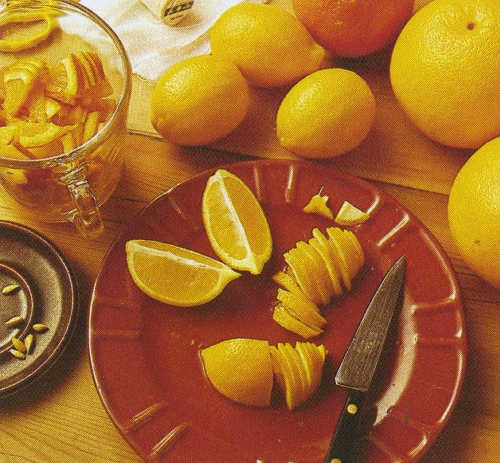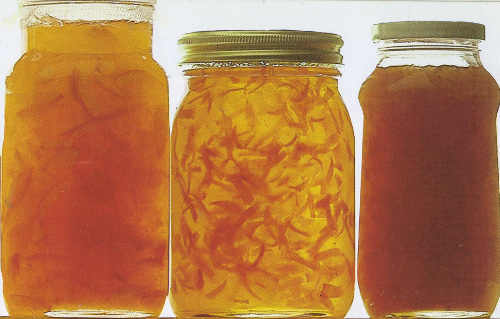In Season - Citrus Fruits
 Cultivated since ancient times, the best-known citrus fruits are the oranges, lemons, grapefruit, limes and tangerines. Citrus plants hybridise easily and kumquats are among the many related fruits. The trees and shrubby plants are sensitive to cold but can be grown here fairly successfully in tubs if they are given protection in winter.
Cultivated since ancient times, the best-known citrus fruits are the oranges, lemons, grapefruit, limes and tangerines. Citrus plants hybridise easily and kumquats are among the many related fruits. The trees and shrubby plants are sensitive to cold but can be grown here fairly successfully in tubs if they are given protection in winter.
An attractive addition to a porch or conservatory, the spiky evergreen plants reward a little care; the flowers are sweetly scented and are produced continuously, so there may be fruit and flowers at the same time. Fruit fresh from the tree has a delicious flavour unlikely to be found in imported fruit.
Now that most foods are available at any time of year, it is difficult to recall the excitement the beginning of a new season used to generate. But - although most citrus fruits are available from different regions throughout the year - the season for Seville oranges and their other bitter relations is still very short.
They start to come in about mid January and they'll only be in the shops for a few weeks, so pick them up at one if you see them. Interestingly, although the more common sweet orange was a much later arrival in Europe, the bitter orange - of which the best-known variety, the Seville, comes from Spain - was known to the Greeks and Romans.
As far as we know they did not make marmalade with them however - that didn't come along until about 1700, in (of course) Dundee. Do try making your own marmalade: once you do, you'll be hooked for life - the fresh tangy flavour of home-made marmalade is unbeatable and it isn't hard to make either.
Even if you haven't time to make marmalade now, get the oranges as they freeze well - just make sure that you choose a recipe which involves cooking the oranges whole and freeze them in weighed batches. Adding an extra orange or two per batch will allow for any loss of pectin during storage - or make a mixed fruit marmalade, including sweet orange, grapefruit and/or limes, if you leave them longer than anticipated.
Cold and grey as it may be outside, the aroma of marmalade through the house has a wonderful way of evoking the warmth and colour our citrus fruits have left behind.
Points for success:
- Cooking citrus fruit takes much longer than other fruits because of the thickness of the peel, so much more water is needed to allow for evaporation. By the end of the first cooking stage, the contents of the pan should be reduced by half and the peel must be very soft - once the sugar is added, the peel will not soften any more.
- Pectin and acid content is important to obtain a good set in all jam and marmalade making; lemon juice is added to seville orange marmalade to supply the extra acid needed to get a good set and prevent crystallisation.
- When the sugar is added it must be dissolved over low heat before bringing the temperature up top the boil. Once dissolved, a fast rolling boil is needed to bring the marmalade up to boiling point. To allow for safe fast boiling, the reduced pulp should not come more than halfway up the pan. If you don't have a big heavy-based pan suitable for preserves, why not consider sharing one with friends? Alternatively, you can hire preserving pans or big heavy-duty Castle Brand saucepans. (Try Kitchen Complements, Dublin, 2. South Anne Street, Tel:01:770734)
-The longer you boil, the darker the colour and more 'mature' the flavour, but over-boiling produces a half-set, syrupy preserve. If your marmalade has reached setting point and you prefer it darker, add a spoonful or two of treacle instead of boiling longer.
- Setting point is reached when a sugar thermometer reaches 221'F, 105'C, or when a little jam cooled on a cold saucer wrinkles when pushed with a finger or spoon.
- To keep well, the marmalade must be poured into jars which are clean, dry and warm, then leave until completely cold before covering. Store in a cool, dark place.
 RECIPE: Mixed Fruit Marmalade is good at any time, and especially useful when Seville or bitter oranges are in short supply, as the proportion is smaller but the flavour still good.
RECIPE: Mixed Fruit Marmalade is good at any time, and especially useful when Seville or bitter oranges are in short supply, as the proportion is smaller but the flavour still good.
This recipe is from my book, Meals For All Seasons (1992). Makes 8-10 lb/3.6-4.5 Kg
llb/450g bitter oranges
l lb/450g sweet oranges
2 large lemons
1 grapefruit
6 pints water
About 6 lb/2.7 Kg granulated sugar
Scrub the fruit and pick off the discs at the stalk end. Halve fruit and squeeze the juice; reserve.
Quarter the peels and remove any excess pith. Tie the pith and pips loosely in a square of muslin.
Slice the peels as thickly or thinly as you like them, or chop in a liquidiser or food processor - in which case include a little of the measured water with each batch as it is processed.
Put the prepared peel, water and fruit juices into the preserving pan; tie the muslin bag of pips and pith to the pan handle and bring the mixture to the boil.
Cover loosely and simmer for 1.5-2 hours, or until the peel is really tender. Remove the pan from the heat, remove the muslin bag and press between two plates to squeeze out all the juice, then discard the bag.
Measure fruit and juice and add l lb/450g sugar per l pint/600 ml of juice and pulp.
Bring up to the boil and boil hard for 15-20 minutes, until setting point is reached.
Skim, if necessary, or stir in a knob of butter to disperse any small amount of scum.
Cool for 15 minutes then stir to distribute the peel evenly before potting.





There are currently no comments
Leave a comment
Not a member? Register for your free membership now!
Or leave a comment by logging in with: